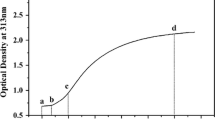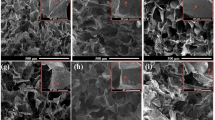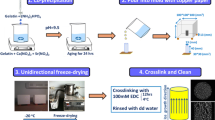Abstract
Biomimetic collagen/hydroxyapatite scaffolds have been prepared by microwave assisted co-titration of phosphorous acid-containing collagen solution and calcium hydroxide-containing solution. The resultant scaffolds have been characterised with respect to their mechanical properties, composition and microstructures. It was observed that the in situ precipitation process could combine collagen fibril formation and hydroxyapatite (HAp) formation in one process step. Collagen fibrils guided hydroxyapatite precipitation to form bone-mimic collagen/hydroxyapatite composite containing both intrafibrillar and interfibrillar hydroxyapatites. The mineral phase was determined as low crystalline calcium-deficient hydroxyapatite with calcium to phosphorus ratio (Ca/P) of 1.4. The obtained 1% (collagen/HAp = 75/25) scaffold has a porosity of 72% and a mean pore size of 69.4 μm. The incorporation of hydroxyapatite into collagen matrix improved the mechanical modulus of the scaffold significantly. This could be attributed to hydroxyapatite crystallites in collagen fibrils which restricted the deformation of the collagen fibril network, and the load transfer of the collagen to the higher modulus mineral component of the composite.
Similar content being viewed by others
References
Zhou H, Lee J. Nanoscale hydroxyapatite particles for bone tissue engineering. Acta Biomaterialia, 2011, 7, 2769–2781.
Olszta M J, Cheng X G, Jee S S, Kumar R, Kim Y Y, Kaufman M J, Douglas E P, Gower L B. Bone structure and formation: A new perspective. Materials Science and Engineering: R: Reports, 2007, 58, 77–116.
Schmidt T, Stachon S, Mack A, Rohde M, Just L. Evaluation of a thin and mechanically stable collagen cell carrier. Tissue Engineering: Part C: Methods, 2011, 17, 1161–1170.
Lees S. Mineralization of type 1 collagen. Biophysical Journal, 2003, 85, 204–207.
Ficai A, Andronescu E, Voicu G, Ghitulica C, Vasile B S, Ficai D, Trandafir V. Self-assembled colla-gen/hydroxyapatite composite materials. Chemical Engineering Journal, 2010, 160, 794–800.
Wahl D A, Czernuszka J T. Collagen-hydroxyapatite composites for hard tissue repair. European Cells and Materials, 2006, 11, 43–56.
Freche M, Heughebaert J C. Calcium phosphate precipitation in the 60-80°C range. Journal of Crystal Growth, 1989, 94, 947–954.
Lawson A C, Czernuszka J T. Collagen-calcium phosphate composites. Proceedings of Institution of Mechanical Engineers: Part H, 1998, 212, 413–425.
Langer R, Vacanti J P. Tissue engineering. Science, 1993, 260, 920–927.
Mastrogiacomo M, Scaglione S, Martinetti R, Dolcini L, Beltrame F, Cancedda R, Quarto R. Role of scaffold internal structure on in vivo bone formation in macroporous calcium phosphate bioceramics. Biomaterials, 2006, 27, 3230–3237.
Liu C Z, Czernuszka J T. Development of biodegradable scaffolds for tissue engineering: A perspective on emerging technology. Materials Science and Technology, 2007, 23, 379–391.
Sachlos E, Gotora D, Czernuszka J T. Collagen scaffolds reinforced with biomimetic composite nano-sized carbonate-substituted hydroxyapatite crystals and shaped by rapid prototyping to contain internal microchannels. Tissue Engineering, 2006, 12, 2479–2487.
Bradt J-H, Mertig M, Teresiak A, Pompe W. Biomimetic mineralization of collagen by combined fibril assembly and calcium phosphate formation. Chemistry of Materials, 1999, 11, 2694–2701.
Palmer L C, Newcomb C J, Kaltz S R, Spoeke E D, Stupp S I. Biomimetic systems for hydroxyapatite mimeralization inspired by bone and enamel. Chemical Review, 2008, 108, 4754–4783.
Liao S S, Cui F, Zhang W, Feng Q. Hierarchically biomi-metic bone scaffold materials: Nano-HA/collagen/PLA composite. Journal of Biomedical Materials Research Part B: Applied Biomaterials, 2004, 69B, 158–165.
Suchanek W, Yoshimura M. Processing and properties of hydroxyapatite-based biomaterials for use as hard tissue replacement implants. Journal of Materials Research, 1998, 13, 94–117.
Kikuchi M, Ikoma T, Itoh S, Matsumoto H N, Koyama Y, Takakuda K, Shinomiya K, Tanaka J. Biomimetic synthesis of bone-like nanocomposites using the self-organization mechanism of hydroxyapatite and collagen. Composites Science and Technology, 2004, 64, 819–825.
O’Brien F J, Harley B A, Yannas I V, Gibson L J. The effect of pore size on cell adhesion in collagen-GAG scaffolds. Biomaterials, 2005, 26, 433–441.
Liu C, Xia Z, Czernuszka J T. Design and development of three-dimensional scaffolds for tissue engineering. Chemical Engineering Research and Design, 2007, 85, 1051–1064.
Liu C Z, Xia Z D, Han Z W, Hulley P A, Triffitt J T, Czernuszka J T. Novel 3D collagen scaffolds fabricated by indirect printing technique for tissue engineering. Journal of Biomedical Materials Research B: Applied Biomaterials, 2008, 85, 519–528.
Yunoki S, Ikoma T, Monkawa A, Ohta K, Kikuchi M, Sotome S, Shinomiya K, Tanaka J. Control of pore structure and mechanical property in hydroxyapatite/collagen composite using unidirectional ice growth. Materials Letters, 2006, 60, 999–1002.
Sachlos E, Reis N, Ainsley C, Derby B, Czermuszka J T. Novel collagen scaffolds with predefined internal morphology made by solid freeform fabrication. Biomaterials, 2003, 24, 1487–1497.
Wahl D A, Sachlos E, Liu C Z, Czernuszka J T. Controlling the processing of collagen-hydroxyapatite scaffolds for bone tissue engineering. Journal of Materials Science: Materials in Medicine, 2007, 18, 201–209.
Feldkamp L A, Goldstein S A, Parfitt A M, Jesion G, Kleerekoper M. The direct examination of three dimensional bone architecture in vitro by computed tomography. Journal of Bone and Mineral Research, 1989, 4, 3–11.
Haddock S M, Debes J C, Nauman E A, Fong K E, Arramon Y P, Keaveny T M. Structure — function relationships for coralline hydroxyapatite bone substitute. Journal of Biomedical Materials Research, 1999, 47, 71–78.
Weiner S, Wagner H D. The material bone: Structure-mechanical function relations. Annual Review of Materials Research, 1998, 28, 271–298.
Liu C, Han Z, Czernuszka J T. Gradient colla-gen/nanohydroxyapatite composite scaffold: Development and characterization. Acta Biomaterialia, 2009, 5, 661–669.
Chang M C, Tanaka J. FT-IR study for hydroxyapa-tite/collagen nanocomposite cross-linked by glutataldehyde. Biomaterials, 2002, 23, 4811–4818.
Koutsopoulos S. Synthesis and characterization of hy-droxyapatite crystals: A review study on the analytical methods. Journal of Biomedical Materials Research, 2002, 62, 600–612.
Müller F A, Müller L, Caillard D, Conforto E. Preferred growth orientation of biomimetic apatite crystals. Journal of Crystal Growth, 2007, 304, 464–471.
Kikuchi M, Itoh S, Ichinose S, Shinomiya K, Tanaka J. Self-organization mechanism in a bone-like hydroxyapa-tite/collagen nanocomposites synthesized in vitro and its biological reaction in vivo. Biomaterials, 2001, 22, 1705–1711.
Katsuki H, Furuta S. Microwave—versus conventional—hydrothermal synthesis of hydroxyapatite crystals from gypsum. Journal of the American Ceramic Society, 2004, 82, 2257–2259.
Vani R, Raja S B, Sridevi T S, Savithri K, Devaraj S N, Girija E K, Thamizhavel A, Kalkura S N. Surfactant free rapid synthesis of hydroxyapatite nanorods by a microwave irradiation method for the treatment of bone infection. Nanotechnology, 2011, 22, 285701–285710.
Piez KA, Miller A. The structure of collagen fibrils. Journal of Supramolecular Structure, 1974, 2, 121–137.
Osaka A, Miura Y, Takeuchi K, Asada M, Takahashi K. Calcium apatite prepared from calcium hydroxide and or-thophosphoric acid. Journal of Materials Science: Materials in Medicine, 1991, 2, 51–55.
Margolis H C, Moreno E C. Kinetics of hydroxyapatite dissolution in acetic, lactic and phosphoric acid solutions. Calcified Tissue International, 1992, 50, 137–143.
Author information
Authors and Affiliations
Corresponding author
Rights and permissions
About this article
Cite this article
Wang, J., Liu, C. Biomimetic Collagen/Hydroxyapatite Composite Scaffolds: Fabrication and Characterizations. J Bionic Eng 11, 600–609 (2014). https://doi.org/10.1016/S1672-6529(14)60071-8
Published:
Issue Date:
DOI: https://doi.org/10.1016/S1672-6529(14)60071-8




